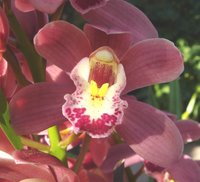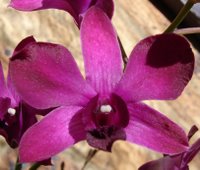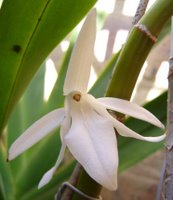In The Greenhouse (06/06)
Somehow, there's always a month where not much is happening, even though it's supposedly peak orchid season. This is probably due to the fact that subtle changes in weather patterns sync up all the plants in my greenhouse and under shade net outside in the cold. The autumn flowering has come and gone. Lots of buds promise beauty for late winter and early spring, but at the moment it is kind of quiet. I'll get some photos and comments up about the Winter Show of the Orchid Society of the Northern Transvaal which will be running from 30 June to 2 July. I think that this will more than make up for this month's modest offerings.
 Cymbidium Leodogran Cradlemont. I inherited this orchid from my aunt when she moved to George. Cymbidiums are notoriously difficult to flower at the seaside, where the maritime climate prevents the large differences in day and night temperatures that these denizens of the Himalaya foothills require. This cultivar received an award of merit from the American Orchid Society. It's a strong grower and very floriferous. The flowers tend to cluster together - although this may just be because of the way I grow it. It is highly fragrant, a heady combination of halva and frangipani (well, that's how I would describe it). Scented Cymbidiums are quite rare and to find one that is also something to look at is rather special.
Cymbidium Leodogran Cradlemont. I inherited this orchid from my aunt when she moved to George. Cymbidiums are notoriously difficult to flower at the seaside, where the maritime climate prevents the large differences in day and night temperatures that these denizens of the Himalaya foothills require. This cultivar received an award of merit from the American Orchid Society. It's a strong grower and very floriferous. The flowers tend to cluster together - although this may just be because of the way I grow it. It is highly fragrant, a heady combination of halva and frangipani (well, that's how I would describe it). Scented Cymbidiums are quite rare and to find one that is also something to look at is rather special.
 Potinara Atomic Mushroom. Yummy. Potinara is the name given to a hybrid between four completely different (yet related) genera: Cattleya, Laelia, Brassavola and Sophronitis. The result is usually a compact-growing plant with brightly coloured flat flowers. This one does what it says on the packet, exploding with the nuclear colours seen in Hiroshima, Bikini Atoll and in the Nevada desert. And it's tiny. The flowers only measure about 4cm across.
Potinara Atomic Mushroom. Yummy. Potinara is the name given to a hybrid between four completely different (yet related) genera: Cattleya, Laelia, Brassavola and Sophronitis. The result is usually a compact-growing plant with brightly coloured flat flowers. This one does what it says on the packet, exploding with the nuclear colours seen in Hiroshima, Bikini Atoll and in the Nevada desert. And it's tiny. The flowers only measure about 4cm across.
 Dendrobium Dal's Glory x Blue Twinkle. A cross that hasn't been registered with it's own name yet. The flowers are not as large or rounded as some of the more commonly seen hardcane Dendrobiums, but the intensity of colour delivers impact nevertheless. This is one of the few hardcane Dendrobiums I keep under shade net - it doesn't seem to mind the cold and I do think the colours are that bit darker because of it.
Dendrobium Dal's Glory x Blue Twinkle. A cross that hasn't been registered with it's own name yet. The flowers are not as large or rounded as some of the more commonly seen hardcane Dendrobiums, but the intensity of colour delivers impact nevertheless. This is one of the few hardcane Dendrobiums I keep under shade net - it doesn't seem to mind the cold and I do think the colours are that bit darker because of it. Jumellea arachnantha. This thing was impossible to photograph well, because the plant is enormous and obscured by various other things. The species name means 'spider-flower' and is quite apt. This species comes from the Comoros, a group of islands off the east coast of Africa. It is a beautiful plant with long strap-shaped leaves held in a fan shape. During winter a multitude of white flowers emerge from the leaf bases, carried singly by thin inflorescences about 20cm long.
Jumellea arachnantha. This thing was impossible to photograph well, because the plant is enormous and obscured by various other things. The species name means 'spider-flower' and is quite apt. This species comes from the Comoros, a group of islands off the east coast of Africa. It is a beautiful plant with long strap-shaped leaves held in a fan shape. During winter a multitude of white flowers emerge from the leaf bases, carried singly by thin inflorescences about 20cm long.
 Cymbidium Leodogran Cradlemont. I inherited this orchid from my aunt when she moved to George. Cymbidiums are notoriously difficult to flower at the seaside, where the maritime climate prevents the large differences in day and night temperatures that these denizens of the Himalaya foothills require. This cultivar received an award of merit from the American Orchid Society. It's a strong grower and very floriferous. The flowers tend to cluster together - although this may just be because of the way I grow it. It is highly fragrant, a heady combination of halva and frangipani (well, that's how I would describe it). Scented Cymbidiums are quite rare and to find one that is also something to look at is rather special.
Cymbidium Leodogran Cradlemont. I inherited this orchid from my aunt when she moved to George. Cymbidiums are notoriously difficult to flower at the seaside, where the maritime climate prevents the large differences in day and night temperatures that these denizens of the Himalaya foothills require. This cultivar received an award of merit from the American Orchid Society. It's a strong grower and very floriferous. The flowers tend to cluster together - although this may just be because of the way I grow it. It is highly fragrant, a heady combination of halva and frangipani (well, that's how I would describe it). Scented Cymbidiums are quite rare and to find one that is also something to look at is rather special.  Potinara Atomic Mushroom. Yummy. Potinara is the name given to a hybrid between four completely different (yet related) genera: Cattleya, Laelia, Brassavola and Sophronitis. The result is usually a compact-growing plant with brightly coloured flat flowers. This one does what it says on the packet, exploding with the nuclear colours seen in Hiroshima, Bikini Atoll and in the Nevada desert. And it's tiny. The flowers only measure about 4cm across.
Potinara Atomic Mushroom. Yummy. Potinara is the name given to a hybrid between four completely different (yet related) genera: Cattleya, Laelia, Brassavola and Sophronitis. The result is usually a compact-growing plant with brightly coloured flat flowers. This one does what it says on the packet, exploding with the nuclear colours seen in Hiroshima, Bikini Atoll and in the Nevada desert. And it's tiny. The flowers only measure about 4cm across.  Dendrobium Dal's Glory x Blue Twinkle. A cross that hasn't been registered with it's own name yet. The flowers are not as large or rounded as some of the more commonly seen hardcane Dendrobiums, but the intensity of colour delivers impact nevertheless. This is one of the few hardcane Dendrobiums I keep under shade net - it doesn't seem to mind the cold and I do think the colours are that bit darker because of it.
Dendrobium Dal's Glory x Blue Twinkle. A cross that hasn't been registered with it's own name yet. The flowers are not as large or rounded as some of the more commonly seen hardcane Dendrobiums, but the intensity of colour delivers impact nevertheless. This is one of the few hardcane Dendrobiums I keep under shade net - it doesn't seem to mind the cold and I do think the colours are that bit darker because of it. Jumellea arachnantha. This thing was impossible to photograph well, because the plant is enormous and obscured by various other things. The species name means 'spider-flower' and is quite apt. This species comes from the Comoros, a group of islands off the east coast of Africa. It is a beautiful plant with long strap-shaped leaves held in a fan shape. During winter a multitude of white flowers emerge from the leaf bases, carried singly by thin inflorescences about 20cm long.
Jumellea arachnantha. This thing was impossible to photograph well, because the plant is enormous and obscured by various other things. The species name means 'spider-flower' and is quite apt. This species comes from the Comoros, a group of islands off the east coast of Africa. It is a beautiful plant with long strap-shaped leaves held in a fan shape. During winter a multitude of white flowers emerge from the leaf bases, carried singly by thin inflorescences about 20cm long.
12 comments:
Hello EOH!
I am first!
This is beautiful! Love the flowers. I don't know anything about flowers-but I can say HEY! that is real pretty!
Thanks! I'm trying to group all my greenhouse posts together in the side bar, but don't know jack about HTML code! I'm not much of a photographer, but at least I'm sincere. I really like gm's blog. He's a superb photographer.
Shees! Thanks EOH! ;-)
I really like the orchids, esp the last one. How many orchids do you have? Why orchids? They are very beautiful (almost other-wordly...).
I have a collection of about 300 different plants. This is a very small collection compared to the ones some of my friends have amassed! I like orchids because of their beauty and mystery. They take you on a trip to the exotic places they come from: the misty foothills of the Andes, crocodile-infested swamps in New Guinea, Acacia forests in Tanzania, the Everglades, Madagascar. The history of orchid collecting is fascinating: jealousy, madness, murder, crazy Victorians. Their biology is interesting: plants that live suspended in the air in the jungle canopy or sprawling on granite rock faces in full sun, tricking insects into pollinating them in mechanisms so extravagant, so involved, that, were the insects to die out, the orchids would go extinct with them. Orchid culture is a challenge: Masdevallias need cool, moist conditions like those in Inca country to do well, whereas Dendrobium nobile will only flower when given a dry winter rest, even though you desperately want to water it when the leaves start dropping in autumn.
Oh, and they are damn sexy as well, all luscious lips, pink folds and inviting clefts. Some are decidedly weird, and I love those too, with their weird appendages and clashing colours. With 25 000 species (and more being discovered every week) and over 150 000 hybrids, the variety is endless and I will always want more. I am an orchid addict.
thanks for helping me learn lots of new things today......your flowers are beautiful :)
okay, so a friend of mine has a bit of an orchid obsession (started with adaptation,i think). if i wanted to get her one...what would you suggest?
And so it starts...
It depends on where you live, really. If she's on the Highveld, good beginner's orchids are Dendrobium kingianum. Karen would disagree with me, as she's got one too and it's a little straggly for most of the year (mine is quite lush, though). Otherwise Phalaenopsis from Woolies is usually a good buy and they look attractive even without flowers. These adapt well to life indoors and are great apartment dwellers. However, these are easy to kill with love - do NOT overwater them. The instructions on the tag that Woolworths puts on these are a surefire way to death and despair. Rather let me give you advice if you go for a Phalaenopsis. Minicats (small plants of the Cattleya tribe) are wonderfully easy and adaptable, with really bright colours and classic shapes, so maybe I'd go for one of those. The Potinara Atomic Mushroom in this post is an example of a minicat.
Actually, there's hundreds of things I could suggest that aren't that taxing to grow; you just have to understand their cultural requirements and adjust accordingly. You'll find that they can be much easier than other plants to keep. And if treated correctly, they'll outlive you.
dankie. sy's in bloemfontein van alle plekke - wat sou vir daar die beste wees?
*gasp*
you really *DO* hunt orchids!!
*awe*
theyre beautiful..
Very very cool Pics!!!! I love the biological knowledge you throw in and have. Sweet postings. Do you know as much about other plants and flowers?
Oh my, Looking at your links and I noticed Engrish. I found this hillarious! I sent it to a friend of mine who has a monitoring device on his computer which keeps a record of what he sees, and ranks it as to objectionable content. Apparently, this got him into a lot of trouble. I had to look and look for "trouble" but didn't find anything that bad.
arcadia
Hmmm, Bloemfontein can get quite chilly in winter - good for things that need seasonal changes to initiate flowering. How about a Cymbidium, although they might be a little big for a tiny flat (and rather old-fashioned to some tastes). Softcane Dendrobiums are also good choices, but if you're like Karen, you'll think they're scraggly when not in bloom. I think they look like ikebana, or a colony of miniature succulent palm trees when out of bloom.
neko
Thanks. I'm quite excited about the upcoming shows and the novel things I'm going to see. Always something new to see. And buy.
wreckless
I'm into all things botanical and also grow carnivorous plants, bulbs, bromeliads, cacti and other succulents. Anything beautiful and unusual draws my attention. I like reading gardening books and planning tranquil oases in my mind. So sorry my link got you into trouble. Try finding the book The Joys of Engrish. It's just as hilarious.
Post a Comment